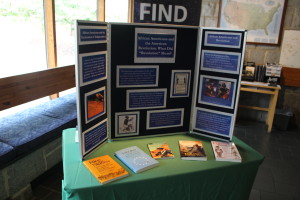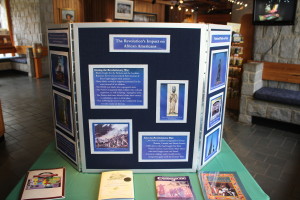As I’m sure you already know, February is Black History Month. I really enjoy learning new things about black history; minorities are certainly under-represented in history books. The Revolutionary War had many blacks – free and slave – fighting.
 One of our projects at work was putting together a temporary display showing some of the contributions of blacks on the War that could be displayed during Black History Month. This was an easy project because Ranger Leah had already put together much of the information we needed. We added some facts and arranged all of it on a display board.
One of our projects at work was putting together a temporary display showing some of the contributions of blacks on the War that could be displayed during Black History Month. This was an easy project because Ranger Leah had already put together much of the information we needed. We added some facts and arranged all of it on a display board.
There are quite a few books on African Americans during the Revolutionary War in our bookstore, so we put some of those around the display. I’ve been reading the biography of John Kizell. The British promised that any slaves who would run away from rebel masters would gain their freedom after the war. John was one of the few who was actually set free: most were returned to their masters as part of the peace agreement. John fought at King’s Mountain on the Loyalist side. After the war, John went to Nova Scotia, then to Sierra Leone, and finally became one of the founders of Liberia.
 Some other facts about African Americans in the Revolutionary War:
Some other facts about African Americans in the Revolutionary War:
At the beginning of the Revolutionary War there were 500,000 blacks in the colonies, about 20% of the population. 50,000 of these were freemen and women. The rest were slaves in both the north and south. Charleston, South Carolina, had a population that was a slave majority because of the rice plantations in the area.
During the War, the Patriots and the British recruited runaway slaves by promising them their freedom if they fought against their masters. When a draft was instituted by the Patriots, masters were allowed to substitute slaves, but they had to give the slaves their freedom if they survived. One slave who fought and was promised freedom, but denied it after the war, took his case to the North Carolina State Legislature which granted his freedom. Over 5,000 blacks – slave and free – served in the Continental army over the course of the war.
After the war about 8,500 slaves who had fought for the Loyalists or the Patriots were freed. Many, especially those who had fought for the Loyalists, were returned to slavery because of the provisions of the peace treaty. The Americans, especially those from Virginia, North Carolina, and South Carolina, would not ratify the peace treaty unless it included the return of runaway slaves.
It was interesting to put together this display for the Visitors Center and learn more about African Americans in the Revolutionary War. What are you learning during Black History Month?
